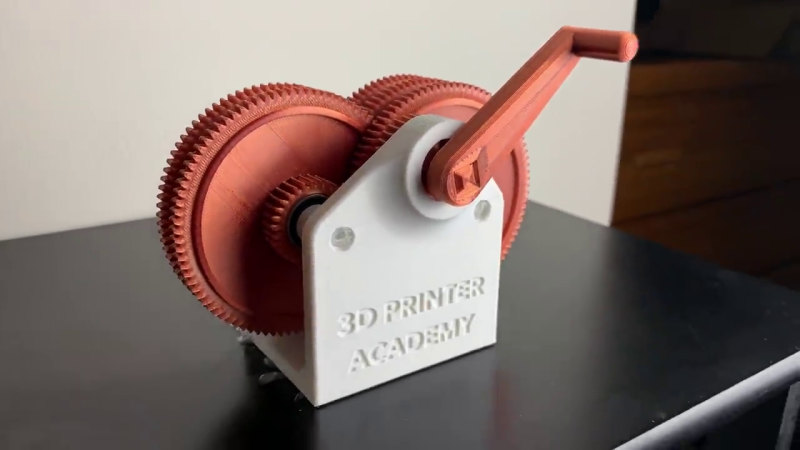[Steven] at the 3D Printer Academy has been working on a variety of different gear designs. He recently embarked on a series of experiments to see how fast he can spin a 3D-printed gearbox.
After testing several kinds of gear teeth, gear diameters, and gear spacing, he finally struck upon an 81:1 ratio gearbox. It has six gears: five stepped gears and one drive gear on the input shaft. First tests are accomplished with a 3D-printed handle, similar to a hand crank used to start really old cars. But unlike those cranks, [Steven]’s doesn’t have any release provision. While the handle can be removed, it can’t be removed while spinning.
We think it would be helpful to revise the drive shaft coupling method, allowing the handle or drill to be easily removed from the gearbox once it’s attained speed. This would be more convenient, and it seems prudent from the workbench safety point of view as well.

[Steven] manages to get the final gear spinning at 7000 RPM in video #2 of the series by hand cranking it “as fast as he can”, a speed measured by using the metronome app on his smartphone. He begins driving the gearbox with an electric drill in video #3, with some mixed but promising results. We think he will ultimately succeed in his goal of a high-speed, electric-drill-driven gearbox after a few more tests. If you want to have a go at this yourself, the design files are posted online.
How fast do you think he can eventually get this gearbox spinning? Are there any physical limitations of the assembly or due to the 3D printing materials/process? We certainly know that high torque can tear 3D-printed gearboxes apart, but how does the speed affect things? Let us know in the comments below.
















I’m tryng to figure out the aim of this project, it seems somewhat pointless. Is it to (a) spin 3D-printed gears until they fly apart, or (b) that the friction becomes so high that it stalls the geartrain? If (a) then cover the gears with a see-through shield. And wouldn’t it be more amenable to hand cranking if the gear housing was screwed down to a fixed surface?
Because seems like a good reason to me. Other people learn and build upon this.
Seems like the kind of prototyping trajectory you’d be on for making a hand cranked dynamo or similar.
I got a nasty looking scar, just above my naval. Chunk of bench missing, pieces of rotor embedded in wall, and others found outside the room, round the corner, and down the hall.
So what was the max rpm ? :)
No clue. https://i.postimg.cc/KcH4DMfY/IMG-0949.jpg
Geez! What was it?
I was expecting a bad angle grinder story. This looks more interesting.
Rotary to linear motion conversion experiment. It worked,…not quite as expected,…and with quite a bang!
Looks like a caster wheel with metal sides, after being spun up with compressed air.
Use ceramic spacers and hermetically seal gearbox with lubricant.
The only problem you are going to have is writing down all the different applications that a hand held or fixed in place hand cranked gearbox that puts out 7000 rpm can be used for.
I’m sure you have ideas already, I know I do ! ☎️
Centrifuge, air raid siren, Wimshurst machine…
My take on speed would be heat generated by friction. At some point the heat would become too much for the gears and they would seize up.
So I could ultimately build upon this to create a pedal driven table saw? A small hand crank cut off saw. Just replace last gear with a blade? Maybe a release mechanism and you have a new Mortal Kombat weapon. Ohh, the places we’ll go.
One obvious killer is inertia and angular acceleration (alright, alright, the “centrifugal force”). Once they overpower cohesive forces inside a fast spinning object, the object’s outer layer fragmentates and scatters its very energetic fragments around, releasing previously accumulated rotational kinetic energy.
Which is to say, make sure you’re standing outside of the rotational plane.
I just finished it and now cranking it up, I wil
Of course, that type of crank was also used for starting early gasoline engines. Once the engine started and was going faster than the human could crank, it would disengage.